| View previous topic :: View next topic |
| Author |
Message |
stevemark

Joined: 29 Apr 2011
Posts: 4087
Location: Switzerland
|
 Posted: Sat Sep 02, 2023 2:17 pm Post subject: Posted: Sat Sep 02, 2023 2:17 pm Post subject: |
 |
|
stevemark wrote:
| D1N0 wrote: |
| I have good experiences with both my Tamron adaptall 70-150's (qz-150m (two touch) and 20a (one touch and more compact) |
Thanks for your "QZ-150" hint - I wasn't aware of its precise naming. It seems my lens has a differnt optical construction from your QZ-150M, although mine doesn't fit any of the variants lsted at lens-db.com. I might be the CZ-715 (f3.8 lens), although my lens has a MFD of 1.5 m (just as the f3.5 CZ-150/CZ-150M ...
https://lens-db.com/tamron-70-150mm-f38-cz-715-1976/
https://lens-db.com/tamron-70-150mm-f35-cz-150-1976/
S
_________________
www.artaphot.ch |
|
| Back to top |
|
 |
rloewy
Joined: 31 Jul 2023
Posts: 15
Location: United States
|
 Posted: Sat Sep 02, 2023 4:01 pm Post subject: Posted: Sat Sep 02, 2023 4:01 pm Post subject: |
 |
|
rloewy wrote:
Yashica Yashinon-dx 35mm 2.8 |
|
| Back to top |
|
 |
Doc Sharptail


Joined: 23 Nov 2020
Posts: 1216
Location: Winnipeg Canada
|
 Posted: Sat Sep 02, 2023 4:21 pm Post subject: Posted: Sat Sep 02, 2023 4:21 pm Post subject: |
 |
|
Doc Sharptail wrote:
| stevemark wrote: |
| D1N0 wrote: |
| I have good experiences with both my Tamron adaptall 70-150's (qz-150m (two touch) and 20a (one touch and more compact) |
Thanks for your "QZ-150" hint - I wasn't aware of its precise naming. It seems my lens has a differnt optical construction from your QZ-150M, although mine doesn't fit any of the variants lsted at lens-db.com. I might be the CZ-715 (f3.8 lens), although my lens has a MFD of 1.5 m (just as the f3.5 CZ-150/CZ-150M ...
https://lens-db.com/tamron-70-150mm-f38-cz-715-1976/
https://lens-db.com/tamron-70-150mm-f35-cz-150-1976/
S |
Try here.
No photo's, but a little less complicated to understand the production differences between the variants.
https://www-tamron-com.translate.goog/jp/consumer/lenses/data/old-lens/cz715.htm?_x_tr_sl=ja&_x_tr_tl=en&_x_tr_hl=en
The Z 210-m series is a bit more difficult to distinguish between the models.
There is also a thread here that dug into these lenses fairly deeply.
I'll look for it later and try to show a link.
-D.S.
_________________
D-810, F2, FTN.
35mm f2 O.C. nikkor
50 f2 H nikkor, 50 f 1.4 AI-s, 135 f3.5 Q,
50 f2 K nikkor 2x, 28-85mm f3.5-4.5 A/I-s, 35-105 3.5-4.5 A/I-s, 200mm f4 Micro A/I, partial list.
"Ain't no half-way" -S.R.V.
"Oh Yeah... Alright" -Paul Simon |
|
| Back to top |
|
 |
Doc Sharptail


Joined: 23 Nov 2020
Posts: 1216
Location: Winnipeg Canada
|
 Posted: Sat Sep 02, 2023 4:45 pm Post subject: Posted: Sat Sep 02, 2023 4:45 pm Post subject: |
 |
|
Doc Sharptail wrote:
http://forum.mflenses.com/old-tamron-manual-focus-lens-serial-numbers-t84035.html
There's one of them. There's a few more like this around, but hard to find with cleared history. Search function here is a bit on the strange side.
-D.S.
_________________
D-810, F2, FTN.
35mm f2 O.C. nikkor
50 f2 H nikkor, 50 f 1.4 AI-s, 135 f3.5 Q,
50 f2 K nikkor 2x, 28-85mm f3.5-4.5 A/I-s, 35-105 3.5-4.5 A/I-s, 200mm f4 Micro A/I, partial list.
"Ain't no half-way" -S.R.V.
"Oh Yeah... Alright" -Paul Simon |
|
| Back to top |
|
 |
stevemark

Joined: 29 Apr 2011
Posts: 4087
Location: Switzerland
|
 Posted: Sat Sep 02, 2023 7:18 pm Post subject: Posted: Sat Sep 02, 2023 7:18 pm Post subject: |
 |
|
stevemark wrote:
That's exactly what made me frown ... my lens looks like the CZ150 3.5/70-150mm (including a fairly flat front lens and a concave rear lens), but it is f3.8 (probably the real f-number which later was changed to f3.5 for marketing purposes), and MFD is 1.5m (not 2m as usually given for the CZ715). SN is 5605308, btw.
| Doc Sharptail wrote: |
There is also a thread here that dug into these lenses fairly deeply.
I'll look for it later and try to show a link.
-D.S. |
Thanks!!
_________________
www.artaphot.ch |
|
| Back to top |
|
 |
Doc Sharptail


Joined: 23 Nov 2020
Posts: 1216
Location: Winnipeg Canada
|
 Posted: Sat Sep 02, 2023 8:37 pm Post subject: Posted: Sat Sep 02, 2023 8:37 pm Post subject: |
 |
|
Doc Sharptail wrote:
Finding definitive information on these lenses is not easy, with most of what is available to read being approximations, and at other times out-right guess-work.
There's a couple of guys here that know a bit of their way around these lenses, certainly more than I do.
-D.S.
_________________
D-810, F2, FTN.
35mm f2 O.C. nikkor
50 f2 H nikkor, 50 f 1.4 AI-s, 135 f3.5 Q,
50 f2 K nikkor 2x, 28-85mm f3.5-4.5 A/I-s, 35-105 3.5-4.5 A/I-s, 200mm f4 Micro A/I, partial list.
"Ain't no half-way" -S.R.V.
"Oh Yeah... Alright" -Paul Simon |
|
| Back to top |
|
 |
vanylapep


Joined: 03 Jan 2014
Posts: 312
|
 Posted: Wed Sep 06, 2023 10:37 pm Post subject: Posted: Wed Sep 06, 2023 10:37 pm Post subject: |
 |
|
vanylapep wrote:
Pentacon Oreston 50mm/f1.8
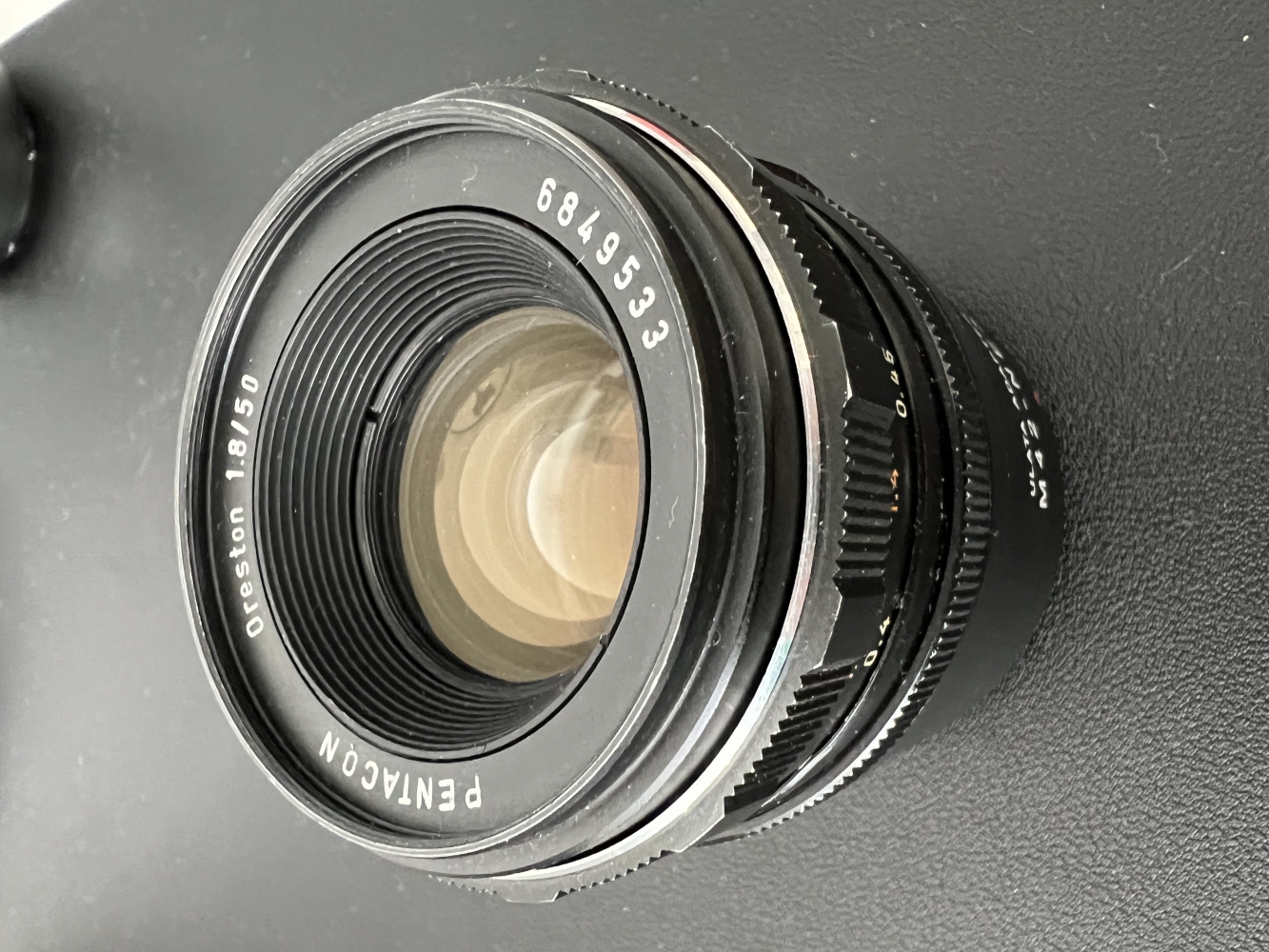 |
|
| Back to top |
|
 |
kypfer

Joined: 27 Sep 2017
Posts: 523
Location: Jersey C.I.
|
 Posted: Fri Sep 08, 2023 10:02 pm Post subject: Fontron 135mm f/2.8 Posted: Fri Sep 08, 2023 10:02 pm Post subject: Fontron 135mm f/2.8 |
 |
|
kypfer wrote:
Received today "bundled" with an EXA 500 that I bought for the included Enna Lithagon 28mm in Sokel fitting (and another Tessar!), was this lens I can find little or nothing about.
Pre-set, with a nice-looking 10-blade aperture and built-in lens hood, if it is T2 mount it's very securely fitted, but not a problem as I've many other 135mm's so I'll not want to be changing the mount on this one 
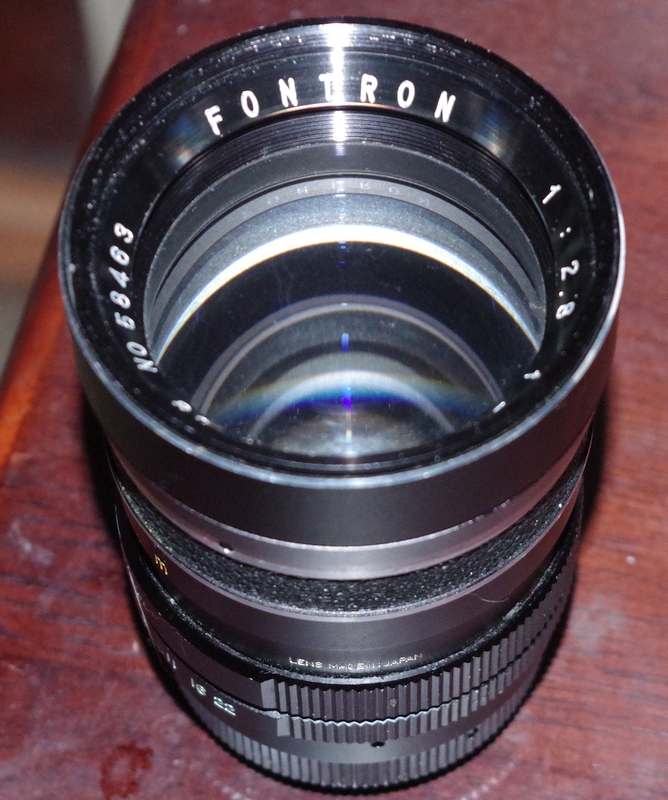 |
|
| Back to top |
|
 |
Nelson


Joined: 06 Jan 2008
Posts: 618
Location: close to Paris, France
|
 Posted: Sat Sep 09, 2023 9:42 am Post subject: Posted: Sat Sep 09, 2023 9:42 am Post subject: |
 |
|
Nelson wrote:
Just received
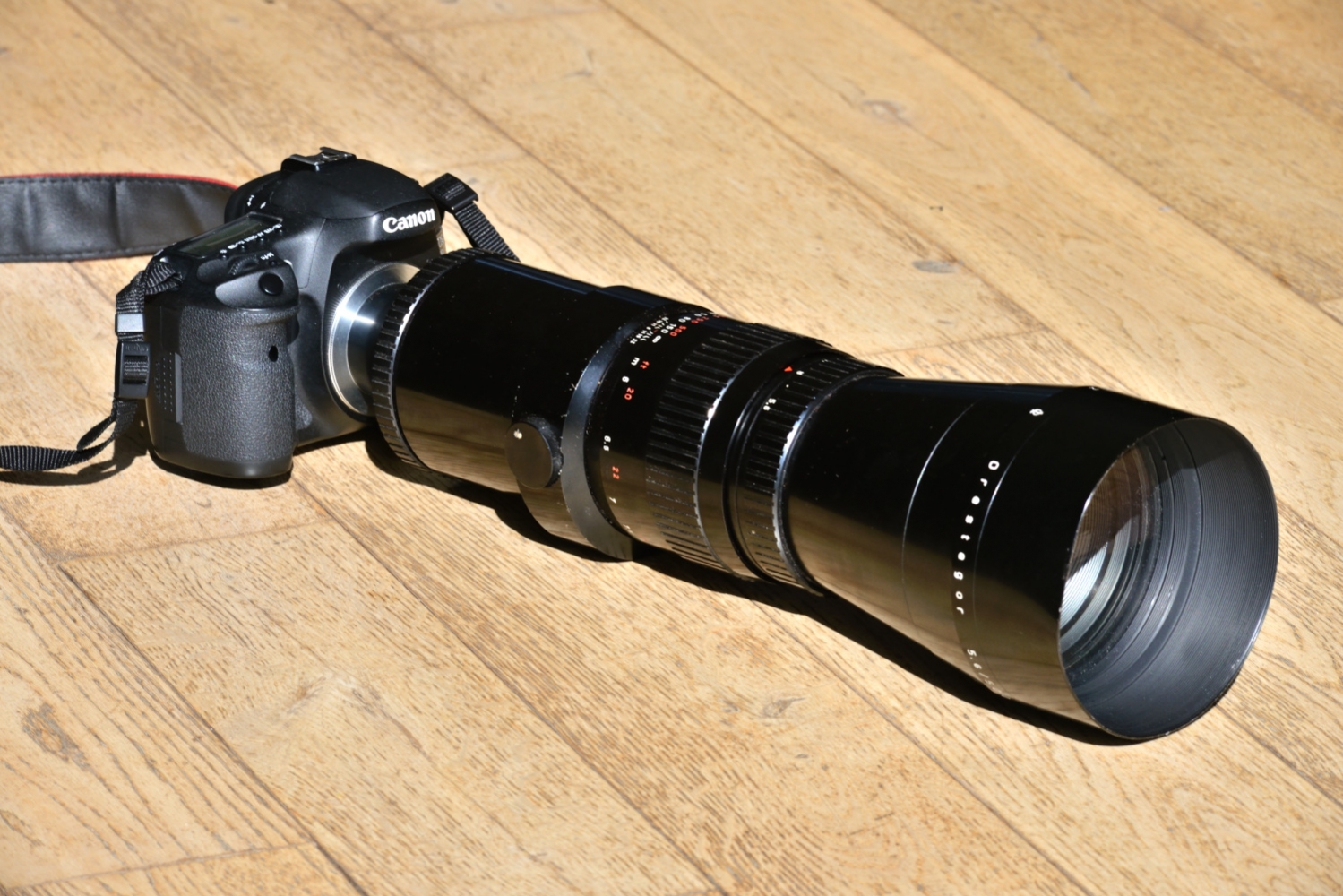

_________________
DSLR : EOS 350D, 300D, 7D, 5D
Pentacon 50 f1.8, 135 f2.8, 200 f4;
TAIR 3S
Helios 44/2
Meyer Optik Orestegor 200mm f4 Orestegor 300mm f4
Tamron 24mm f2.5 01B, 300mm f5.6 670Au, 75 250, 300mm f5.6 SP 54B, 500mm f8 SP 55B, SP 70 210 3.5, SP 60 300
my MF lenses
EF 50 1.8 I, EF 100macro f2.8, EF 70-200 F4 L is, EFS 17-55 f2.8 is, Sigma 10-20 EX, 18-50 2.8 EX, 300 f4 hsm, 400 5.6 hsm |
|
| Back to top |
|
 |
D1N0


Joined: 07 Aug 2012
Posts: 2537
|
 Posted: Sat Sep 09, 2023 10:47 am Post subject: Posted: Sat Sep 09, 2023 10:47 am Post subject: |
 |
|
D1N0 wrote:
| stevemark wrote: |
| D1N0 wrote: |
| I have good experiences with both my Tamron adaptall 70-150's (qz-150m (two touch) and 20a (one touch and more compact) |
Thanks for your "QZ-150" hint - I wasn't aware of its precise naming. It seems my lens has a differnt optical construction from your QZ-150M, although mine doesn't fit any of the variants lsted at lens-db.com. I might be the CZ-715 (f3.8 lens), although my lens has a MFD of 1.5 m (just as the f3.5 CZ-150/CZ-150M ...
https://lens-db.com/tamron-70-150mm-f38-cz-715-1976/
https://lens-db.com/tamron-70-150mm-f35-cz-150-1976/
S |
according to lensdb both cz-715 and cz-150 are 465 grams and 64.5*117mm (so likely pretty much identical)
QZ-150 is 550 grams and 64.5*125mm 02A is 585 grams and 64.5*125mm (the Adaptall-2 version of the QZ-150) the 20a is a new push/pull design, lighter and more compact.
_________________
pentaxian |
|
| Back to top |
|
 |
stevemark

Joined: 29 Apr 2011
Posts: 4087
Location: Switzerland
|
 Posted: Sat Sep 09, 2023 3:02 pm Post subject: Posted: Sat Sep 09, 2023 3:02 pm Post subject: |
 |
|
stevemark wrote:
| D1N0 wrote: |
| stevemark wrote: |
| D1N0 wrote: |
| I have good experiences with both my Tamron adaptall 70-150's (qz-150m (two touch) and 20a (one touch and more compact) |
Thanks for your "QZ-150" hint - I wasn't aware of its precise naming. It seems my lens has a differnt optical construction from your QZ-150M, although mine doesn't fit any of the variants lsted at lens-db.com. I might be the CZ-715 (f3.8 lens), although my lens has a MFD of 1.5 m (just as the f3.5 CZ-150/CZ-150M ...
https://lens-db.com/tamron-70-150mm-f38-cz-715-1976/
https://lens-db.com/tamron-70-150mm-f35-cz-150-1976/
S |
according to lensdb both cz-715 and cz-150 are 465 grams and 64.5*117mm (so likely pretty much identical)
QZ-150 is 550 grams and 64.5*125mm 02A is 585 grams and 64.5*125mm (the Adaptall-2 version of the QZ-150) the 20a is a new push/pull design, lighter and more compact. |
I had been looking at these data before. It seems they started manufacturing the CZ150 (with 1.5m MFD, instead of the previous 2m of the ZC715), abut at the beginning still were using the "f3.8" front rings of the earlier CZ715 ...
S
_________________
www.artaphot.ch |
|
| Back to top |
|
 |
stevemark

Joined: 29 Apr 2011
Posts: 4087
Location: Switzerland
|
 Posted: Sat Sep 09, 2023 3:42 pm Post subject: Posted: Sat Sep 09, 2023 3:42 pm Post subject: |
 |
|
stevemark wrote:
Early Nikkor-Q Auto 1:4 f=20cm today (left lens; here shown with a later Nikkor-Q Auto 1:4 f=200mm on the right). The Nikkor-Q 1:4 f=20cm has a somehow different optical construction than all the later Nikkor-Q 1:4 f=200mm lenses, as reported by Kouichi Ohshita in his Nikkor Tale No 48 (https://imaging.nikon.com/imaging/information/story/0048/).
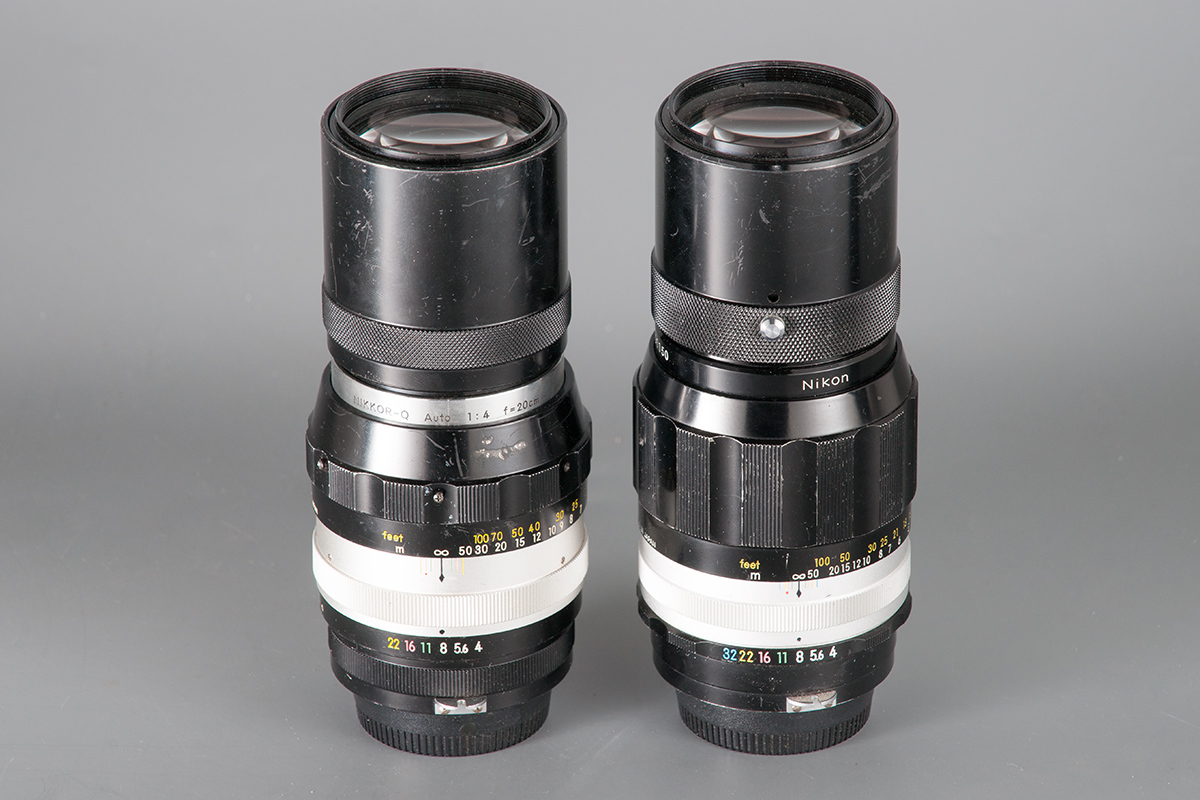
For time being I cannot compare the two versions since the early version i just got sadly is defective (focusing goes only to about 15m instaed to infinity, and the entire lens block is wobbly). I'm pretty sure there's no real damag though, and I will keep the lens since it doesn't appear often here in Switzerland.
Richard Haw has extensive repair information for this early version on his excellent website, and therefore repairing should not be a major problem (https://richardhaw.com/2017/01/01/repair-nikkor-q-20cm-f4/)
S
_________________
www.artaphot.ch |
|
| Back to top |
|
 |
stevemark

Joined: 29 Apr 2011
Posts: 4087
Location: Switzerland
|
 Posted: Sat Sep 09, 2023 3:43 pm Post subject: Posted: Sat Sep 09, 2023 3:43 pm Post subject: |
 |
|
stevemark wrote:
Mamiya Sekor E 4/300mm - an extremely rare lens for sure (mine has SN 10067 and therefore seems to be the 67th lens manufactured).
It's the first time I've seen it for sale here in Switzerland, and I was lucky to get it. According to the data published by Mamiya it seems
to have the same optical formula as the earlier (and more common) Sekor CS 4/300mm. Preliminary tests suggest that the
performance indeed is identical. While the Sekor E 4/300mm on 24 MP FF is very sharp (even wide open and in the corners), it has quite
pronounced lateral CAs - but that's a problem with nearly all "non-ED/AD/ULD/Fluorite" 300mm lenses of course!
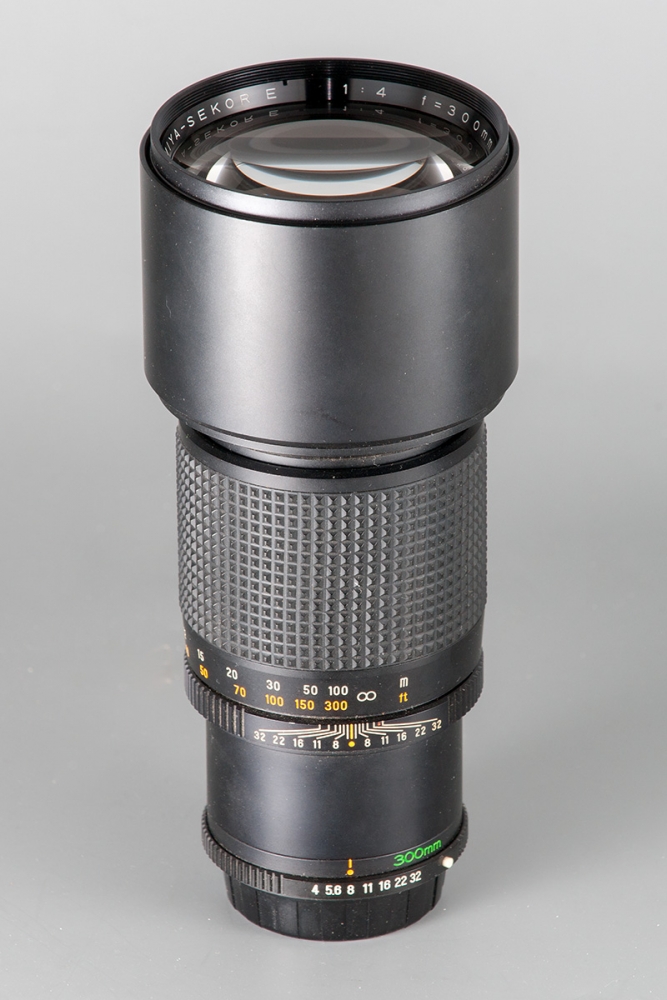
The Sekor E 4/300mm is one of the several Sekor E lenses I tried to buy just after the collapse of the Mamiya / Osawa / ... empire;
back in 1984. The Swiss representative of Mamiya was selling many of the less common Sekor E lenses for a fraction of their original
price, and being 15 yo their offers were quite tempting. While the E 2.8/28, the EF 1.4/50, and the E 4/200 were still available when I heard
about it, they had sold their last E 4/300 just one day ago. Of course I was deeply disappointed, but alas ... here we go.
After nearly fourty years the lens has arrived, finally ... 
At a mere 740 g (measured) the Sekor E 4/300 is probably the lightest of its class (the earlier Sekor CS was 785 g). Compare this to
the Nikkor-H Auto 4.5/300 at 1070g, the Canon nFD 4/300 at 950 g or the Minolta MC-X 4.5/300 at 1180 g ... only the Minölta
MD 4.5/300 is comparable: 775 g, but only f4.5 of course.
The biggest disadvantage of the Mamiya Sekor CS and E 4/300mm lenses of course is their MFD: At 5.0 m its MFD is even worse than
the MC-X (4.5m) or the Nikkor-H (4.0m). Of course the MD and the nFD are much better (3.0 m) since they are IF designs.
Here's the Sekor E with its 2.8/135mm and 4/200mm cousins (at the left), plus the two telezooms 3.8/80-200mm and 4/80-200mm:
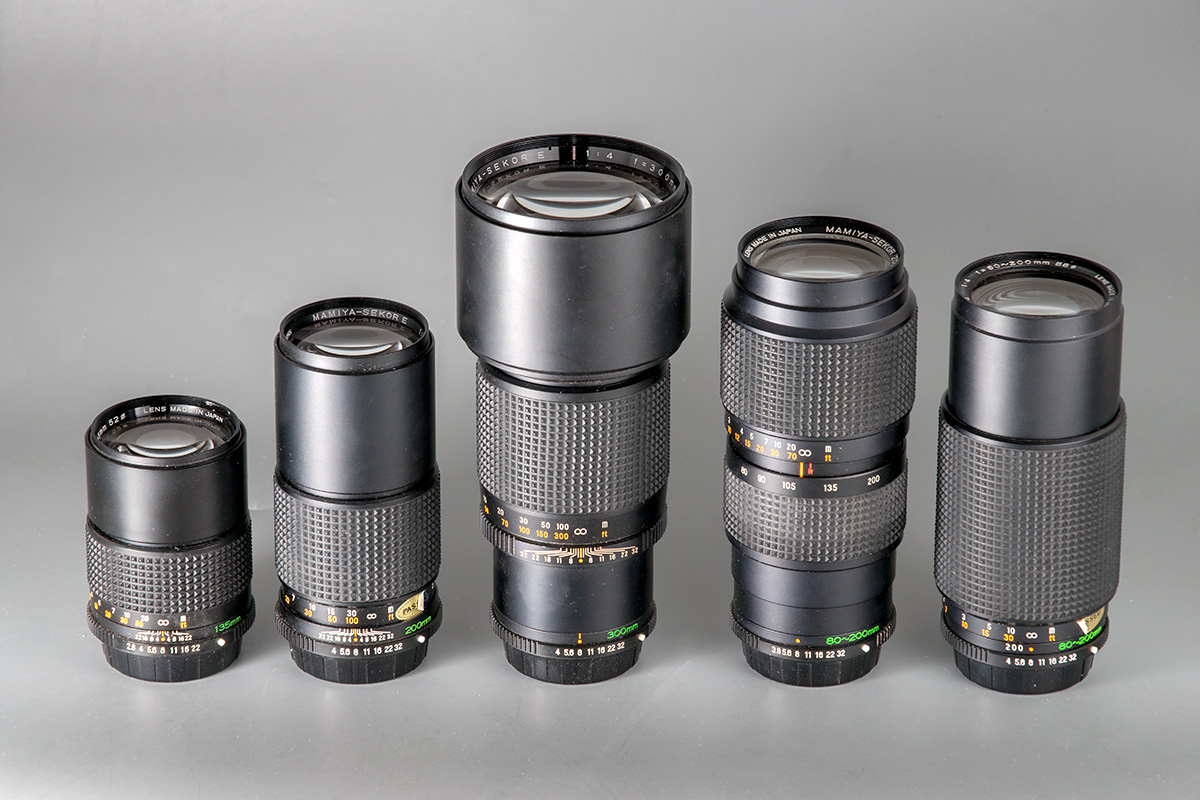
The latter is a pretty rare lens as well (of course not as rare as the E 4/300mm) - while it looks like a re-badged Tokina 4/80-200 at first, it certainly has a completely different optical construction, and probably is a real Mamiya computation (remember - they had
excellent 4.5/105-210mm tele lenses for their 645 system back then).
BTW I'll publish a few more "lens porn" images of this and other Mamiya lenses/cameras in the "Show your Camera" thread 
S
_________________
www.artaphot.ch
Last edited by stevemark on Sat Sep 09, 2023 4:57 pm; edited 2 times in total |
|
| Back to top |
|
 |
Doc Sharptail


Joined: 23 Nov 2020
Posts: 1216
Location: Winnipeg Canada
|
 Posted: Sat Sep 09, 2023 4:20 pm Post subject: Posted: Sat Sep 09, 2023 4:20 pm Post subject: |
 |
|
Doc Sharptail wrote:
| stevemark wrote: |
Early Nikkor-Q Auto 1:4 f=20cm today
For time being I cannot compare the two versions since the early version i just got sadly is defective (focusing goes only to about 15m instaed to infinity, and the entire lens block is wobbly). I'm pretty sure there's no real damag though, and I will keep the lens since it doesn't appear often here in Switzerland.
Richard Haw has extensive repair information for this early version on his excellent website, and therefore repairing should not be a major problem S |
The protruding cross-head screws on the 20 CM's focus ring say a lot about the lens' history.
Richard Haw's site is a good one. Do search for other videos though- it isn't always necessary to seperate the helicoids when repairing old nikkors.
-D.S.
_________________
D-810, F2, FTN.
35mm f2 O.C. nikkor
50 f2 H nikkor, 50 f 1.4 AI-s, 135 f3.5 Q,
50 f2 K nikkor 2x, 28-85mm f3.5-4.5 A/I-s, 35-105 3.5-4.5 A/I-s, 200mm f4 Micro A/I, partial list.
"Ain't no half-way" -S.R.V.
"Oh Yeah... Alright" -Paul Simon |
|
| Back to top |
|
 |
stevemark

Joined: 29 Apr 2011
Posts: 4087
Location: Switzerland
|
 Posted: Sat Sep 09, 2023 5:10 pm Post subject: Posted: Sat Sep 09, 2023 5:10 pm Post subject: |
 |
|
stevemark wrote:
| Doc Sharptail wrote: |
The protruding cross-head screws on the 20 CM's focus ring say a lot about the lens' history. |
Yep, indeed. Unlike most other lenses I buy here in Switzerland, the early Nikkors usually look rather beaten. In the 1960s not many people here had a "real" SLR, let alone a Nikon. I'd guess that most non-standers Nikkor lenses back then were used by professional photographers.
| Doc Sharptail wrote: |
Richard Haw's site is a good one. Do search for other videos though- it isn't always necessary to seperate the helicoids when repairing old nikkors.
-D.S. |
Richard Haw says that this very Nikkor (the early 4/20cm) has its screws well glued on/in, so repairing the lens might be a bit more difficult than originally thought - especially since one of the screws you mentioned is damaged beyond repair (someone tried to get it out, but srewed up). Nevertheless I'll probably be able to extract it, after applying some acetone solvent.
S
_________________
www.artaphot.ch |
|
| Back to top |
|
 |
Doc Sharptail


Joined: 23 Nov 2020
Posts: 1216
Location: Winnipeg Canada
|
 Posted: Sat Sep 09, 2023 7:07 pm Post subject: Posted: Sat Sep 09, 2023 7:07 pm Post subject: |
 |
|
Doc Sharptail wrote:
| stevemark wrote: |
| Doc Sharptail wrote: |
The protruding cross-head screws on the 20 CM's focus ring say a lot about the lens' history. |
Yep, indeed. Unlike most other lenses I buy here in Switzerland, the early Nikkors usually look rather beaten. In the 1960s not many people here had a "real" SLR, let alone a Nikon. I'd guess that most non-standers Nikkor lenses back then were used by professional photographers.
| Doc Sharptail wrote: |
Richard Haw's site is a good one. Do search for other videos though- it isn't always necessary to seperate the helicoids when repairing old nikkors.
-D.S. |
Richard Haw says that this very Nikkor (the early 4/20cm) has its screws well glued on/in, so repairing the lens might be a bit more difficult than originally thought - especially since one of the screws you mentioned is damaged beyond repair (someone tried to get it out, but srewed up). Nevertheless I'll probably be able to extract it, after applying some acetone solvent.
S |
I suspect nikon used an early form of red loctite on these early series lens~ with one screw being locked in with something incredibly hard, to prevent user dis-assembly. I have one Q 135 here in the single/uncoated version here with a bayonet flat head screw head completely torn off. To proceed further, I'd have to drill the remains of the head out. Heat, acetone, and a lot of time and patience are required for getting some of these apart.
-D.S.
_________________
D-810, F2, FTN.
35mm f2 O.C. nikkor
50 f2 H nikkor, 50 f 1.4 AI-s, 135 f3.5 Q,
50 f2 K nikkor 2x, 28-85mm f3.5-4.5 A/I-s, 35-105 3.5-4.5 A/I-s, 200mm f4 Micro A/I, partial list.
"Ain't no half-way" -S.R.V.
"Oh Yeah... Alright" -Paul Simon |
|
| Back to top |
|
 |
Alun Thomas

Joined: 20 Aug 2018
Posts: 662
Location: New Zealand
|
 Posted: Tue Sep 12, 2023 9:13 pm Post subject: Posted: Tue Sep 12, 2023 9:13 pm Post subject: |
 |
|
Alun Thomas wrote:
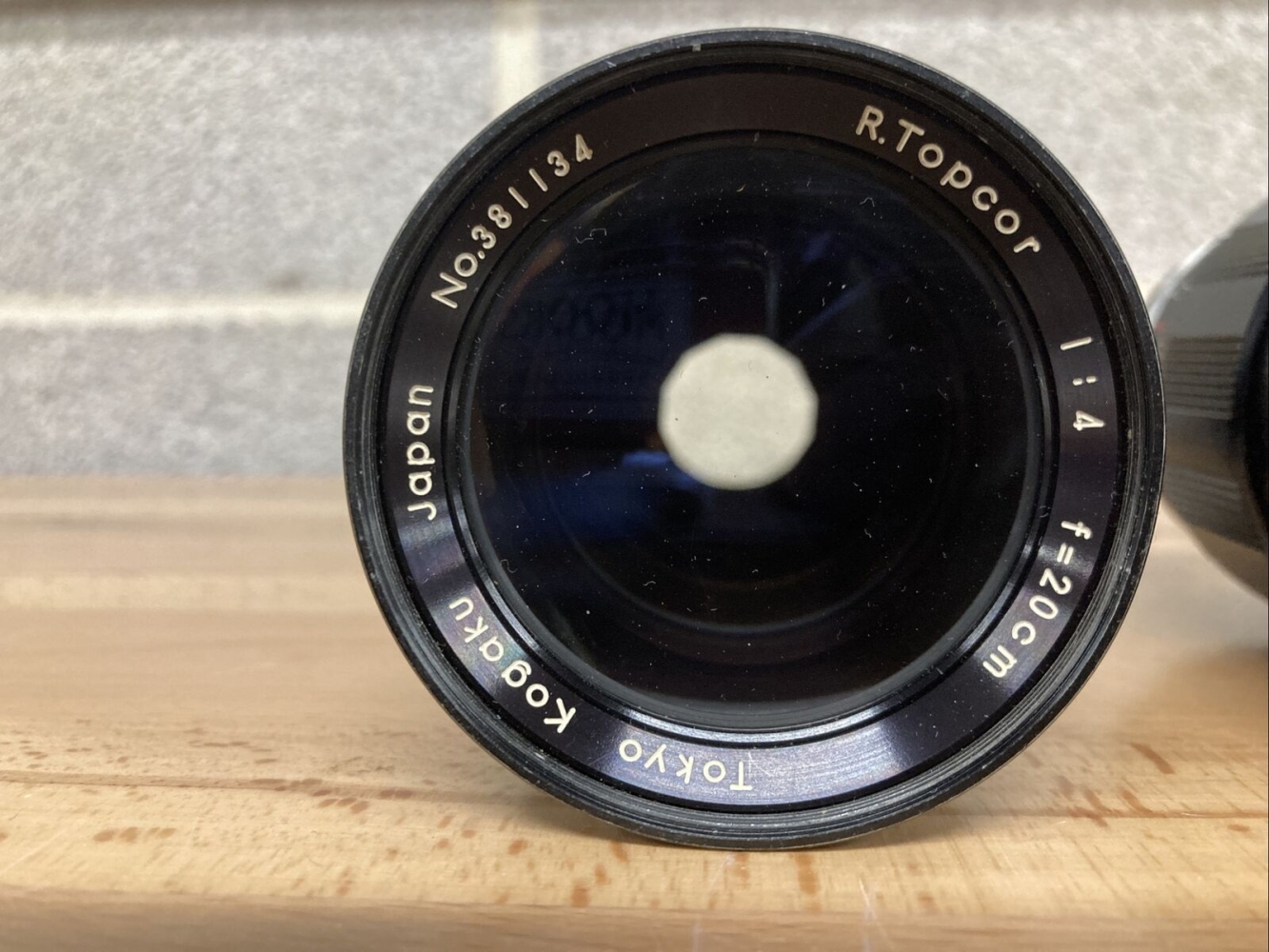
(Sellers pic)
I put a last minute bid on this and got it without any competition. There isn't much out there about this lens, but Topcon lenses during this period were all of a quite high standard optically, at least the ones I've checked so far have been. According to this page ( https://lens-db.com/tokyo-kogaku-r-topcor-200mm-f4-1960/ ) it's a sonnar type scheme, with a triple cemented second element (for automatic cool-factor), so hopefully it's an easy job to do any needed cleaning. The lensdb page has it as a 8 blade aperture, but this copy looks to have twelve fairly straight looking blades.
The second lens not shown was a Mamiya Sekor 135/2.8 for exakta mount prismat camera, in slightly disassembled condition. I asked the seller to hold on to it as the lens is getting posted a long distance and I already have a copy. |
|
| Back to top |
|
 |
kiddo

Joined: 29 Jun 2018
Posts: 1275
|
 Posted: Tue Sep 12, 2023 9:59 pm Post subject: Posted: Tue Sep 12, 2023 9:59 pm Post subject: |
 |
|
kiddo wrote:
| Doc Sharptail wrote: |
| stevemark wrote: |
| Doc Sharptail wrote: |
The protruding cross-head screws on the 20 CM's focus ring say a lot about the lens' history. |
Yep, indeed. Unlike most other lenses I buy here in Switzerland, the early Nikkors usually look rather beaten. In the 1960s not many people here had a "real" SLR, let alone a Nikon. I'd guess that most non-standers Nikkor lenses back then were used by professional photographers.
| Doc Sharptail wrote: |
Richard Haw's site is a good one. Do search for other videos though- it isn't always necessary to seperate the helicoids when repairing old nikkors.
-D.S. |
Richard Haw says that this very Nikkor (the early 4/20cm) has its screws well glued on/in, so repairing the lens might be a bit more difficult than originally thought - especially since one of the screws you mentioned is damaged beyond repair (someone tried to get it out, but srewed up). Nevertheless I'll probably be able to extract it, after applying some acetone solvent.
S |
same as yashica ml 50mm 1.4, screws and rings glued in, acetone won´t unlock it
I suspect nikon used an early form of red loctite on these early series lens~ with one screw being locked in with something incredibly hard, to prevent user dis-assembly. I have one Q 135 here in the single/uncoated version here with a bayonet flat head screw head completely torn off. To proceed further, I'd have to drill the remains of the head out. Heat, acetone, and a lot of time and patience are required for getting some of these apart.
-D.S. |
|
|
| Back to top |
|
 |
caspert79


Joined: 31 Oct 2010
Posts: 3225
Location: The Netherlands
|
 Posted: Wed Sep 13, 2023 4:47 am Post subject: Posted: Wed Sep 13, 2023 4:47 am Post subject: |
 |
|
caspert79 wrote:
| Alun Thomas wrote: |

(Sellers pic)
I put a last minute bid on this and got it without any competition. There isn't much out there about this lens, but Topcon lenses during this period were all of a quite high standard optically, at least the ones I've checked so far have been. According to this page ( https://lens-db.com/tokyo-kogaku-r-topcor-200mm-f4-1960/ ) it's a sonnar type scheme, with a triple cemented second element (for automatic cool-factor), so hopefully it's an easy job to do any needed cleaning. The lensdb page has it as a 8 blade aperture, but this copy looks to have twelve fairly straight looking blades.
|
Nice find!
_________________
For Sale:
Steinheil Auto D Tele Quinar 135mm f/2.8 (Exa)
ISCO Isconar 100mm f/4 (Exa)
Steinheil Cassarit 50mm f/2.8 M39 (Paxette)
I'm always interested in trading lenses! |
|
| Back to top |
|
 |
Manichaean

Joined: 03 Oct 2013
Posts: 70
|
 Posted: Wed Sep 13, 2023 9:47 am Post subject: Posted: Wed Sep 13, 2023 9:47 am Post subject: |
 |
|
Manichaean wrote:
| stevemark wrote: |
The latter is a pretty rare lens as well (of course not as rare as the E 4/300mm) - while it looks like a re-badged Tokina 4/80-200 at first, it certainly has a completely different optical construction, and probably is a real Mamiya computation (remember - they had
excellent 4.5/105-210mm tele lenses for their 645 system back then). |
After reading this comment of yours, I have bought Mamiya-Sekor E 80-200mm f4. Currently it is on the way. How do you rate its performance? Similar to the mentioned Tokina or better? I have one of those Tokinas - it's a solid performer. Not stellar, but considering its low price and wide availability it is also a keeper. |
|
| Back to top |
|
 |
stevemark

Joined: 29 Apr 2011
Posts: 4087
Location: Switzerland
|
 Posted: Wed Sep 13, 2023 7:22 pm Post subject: Posted: Wed Sep 13, 2023 7:22 pm Post subject: |
 |
|
stevemark wrote:
| Manichaean wrote: |
| stevemark wrote: |
The latter is a pretty rare lens as well (of course not as rare as the E 4/300mm) - while it looks like a re-badged Tokina 4/80-200 at first, it certainly has a completely different optical construction, and probably is a real Mamiya computation (remember - they had
excellent 4.5/105-210mm tele lenses for their 645 system back then). |
After reading this comment of yours, I have bought Mamiya-Sekor E 80-200mm f4. Currently it is on the way. How do you rate its performance? Similar to the mentioned Tokina or better? I have one of those Tokinas - it's a solid performer. Not stellar, but considering its low price and wide availability it is also a keeper. |
I don't remember, to be honest - which usually means "neither steller nor really bad" ... I'll check again tomorrow - if the current rain is going to stop ! I'll check again tomorrow - if the current rain is going to stop !
S
_________________
www.artaphot.ch |
|
| Back to top |
|
 |
marcusBMG

Joined: 07 Dec 2012
Posts: 1319
Location: Conwy N Wales
|
 Posted: Thu Sep 14, 2023 8:38 am Post subject: Posted: Thu Sep 14, 2023 8:38 am Post subject: |
 |
|
marcusBMG wrote:
| Quote: |
BTW I'll publish a few more "lens porn" images of this and other Mamiya lenses/cameras in the "Show your Camera" thread Wink
|
Nice pic Steve - excellent lighting. Were you using a light box?
_________________
pentax ME super (retired)
Pentax K3-ii; pentax K-S2; Samsung NX 20; Lumix G1 + adapters;
Adaptall collection (proliferating!) inc 200-500mm 31A, 300mm f2.8, 400mm f4.
Primes: takumar 55mm; smc 28mm, 50mm; kino/komine 28mm f2's, helios 58mm, Tamron Nestar 400mm, novoflex 400mm, Vivitar 135mm close focus, 105mm macro; Jupiter 11A; CZJ 135mm.
A classic zoom or two: VS1 (komine), Kiron Zoomlock... |
|
| Back to top |
|
 |
stevemark

Joined: 29 Apr 2011
Posts: 4087
Location: Switzerland
|
 Posted: Thu Sep 14, 2023 1:13 pm Post subject: Posted: Thu Sep 14, 2023 1:13 pm Post subject: |
 |
|
stevemark wrote:
| marcusBMG wrote: |
| Quote: |
BTW I'll publish a few more "lens porn" images of this and other Mamiya lenses/cameras in the "Show your Camera" thread Wink
|
Nice pic Steve - excellent lighting. Were you using a light box? |
No, Just one flash on the camera and two remotes on left/right. Very simply setup.
S
_________________
www.artaphot.ch |
|
| Back to top |
|
 |
stevemark

Joined: 29 Apr 2011
Posts: 4087
Location: Switzerland
|
 Posted: Thu Sep 14, 2023 1:58 pm Post subject: Posted: Thu Sep 14, 2023 1:58 pm Post subject: |
 |
|
stevemark wrote:
| Manichaean wrote: |
| stevemark wrote: |
The latter is a pretty rare lens as well (of course not as rare as the E 4/300mm) - while it looks like a re-badged Tokina 4/80-200 at first, it certainly has a completely different optical construction, and probably is a real Mamiya computation (remember - they had
excellent 4.5/105-210mm tele lenses for their 645 system back then). |
After reading this comment of yours, I have bought Mamiya-Sekor E 80-200mm f4. Currently it is on the way. How do you rate its performance? Similar to the mentioned Tokina or better? I have one of those Tokinas - it's a solid performer. Not stellar, but considering its low price and wide availability it is also a keeper. |
I just have been comparing the Mamiya Sekor E 3.8/80-200mm, the later Sekro E 4/80-200mm and the conteporary Minolta MD-III 4.5/75-200mm lenses. Images will later oin a separate therad, but here a few preliminary observations (24 MP FF, infinity, tested wide open and at f8.0):
@ 80mm: Mamiya Sekor E 3.8/80-200mm clearly is best. No lateral CAs at all, very good detail resolution even wide open in the extreme corners. The Sekor E 4/80-200mm has a nearly as good resolution, but slight CAs, and the Minolta has slightly inferior resolution at f4.5 plus slight CAs.
@ 135mm: Mamiya Sekor E 3.8/80-200mm again has the best resolution, very good at f3.8 and excellent at f8, but now also slight CAs. Sekor E 4/80-200mm as well as the Minolta 4.5/75-200 have a somehow lower corner resolution wide open, but stopped down they are as good as the Sekor E 3.8/80-200mm at f3.8.
@ 200mm: Again the Mamiya E 3.8/80-200mm has the best corner resolution wide open, but stopped down the Sekor E 4/200mm is comparable or even slightly better. Wide open the Sekor E 4/80-200mm has clearly a reduced corner resolution and quite strong CAs. Wide open, the Minolta is somewhere in between the two Sekors, at f8 it's slightly inferior to them both.
Over all the Sekor E 3.8/80-200mm wins - a result consistent with the elaborate tele zoom test by Walter E Schön, published in the early 1980s. As far I as remember the Sekor 3.8/80-200 was the best lens in the "resolution" departement back then (out of about 15 lenses tested). But of course this was before the arrival of lenses such as the Zeiss CY Vario Sonnar 4/80-200 or the Leitz R 4/80-200 (both were developped by the same lens designer - Lothar Kölsch).
S
_________________
www.artaphot.ch |
|
| Back to top |
|
 |
ZuikosHexanonsandVivitars


Joined: 03 Nov 2021
Posts: 254
Location: Austria
|
 Posted: Fri Sep 15, 2023 10:16 am Post subject: Posted: Fri Sep 15, 2023 10:16 am Post subject: |
 |
|
ZuikosHexanonsandVivitars wrote:
Can someone please point me in the right direction?
I just found a Canon nFD 1.4/50 on the ubiquitous online market place in good condition and so cheap that I had to give in.
Now according to the production code on the bayonet it´s from 1986 (reads A422), but what has happened from the introduction of this lens type in 1979 until Canon stopped production - anyone know an online resource having more information on that?
Many thanks in advance!
_________________
Cheers, Gerhard |
|
| Back to top |
|
 |
|
|
